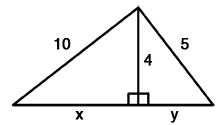Review
GRE Numeric Entry
The numeric entry questions require you to place the answer to the question into a single answer box or as a fraction into two separate boxes — one for the numerator and one for the denominator — using the computer mouse and keyboard. The scope of the numeric entry questions is similar to the type of questions that you'll be given for quantitative comparison and problem solving questions, but you are not provided with a list of choices from which to select the answer.
Example 1

For example 1, you must calculate the values of x and y so that you can compute their sum. Using the Pythagorean Theorem, you can calculate that y=3, and that x=√(100-16)=√84=9.165. Thus, x+y=3+9.165=12.165, and rounded to the next highest integer, the answer is 13. That is the value that you would enter into the box beneath the question.
When providing the answer to a single entry math question, be sure to follow the directions exactly. In most cases, the answer that you'll be asked to provide will be in the form of an integer. So, for example, if you are given a word problem and you are asked to find the percentage of apples in a bucket, and you calculate the answer to 32 percent, you'll need to enter "32", and NOT "32.0" or "32%" or "0.32".
Example 2
What is three-fourths times twelve-sixths?
For example 2, you must calculate the value of three-fourths times twelve-sixths (3/4 × 12/6). The answer, 36/24, has both a numerator and denominator part, which must be entered separately into their respective boxes.
Notice that you do not have to reduce your fraction -- you can enter 36/24, or 18/12, or 9/6, etc.
Submitting your answer
If the numerical entry question is a single-blank question, then you'll use the computer mouse to click inside of the single answer box, and use the keyboard to enter a decimal or integer value. If the numerical entry question requires you to provide a fraction (ratio), then you'll need to supply the numerator and denominator into the respective boxes. For both the single entry and fraction numerical entry questions, equivalent forms of the correct answer are accepted. For example, if the answer to a question is 12.6, then 12.60, as well as 12.600 would be correct. Likewise, if the answer to a fraction is 12/4, then 24/8, as well as 6/3 would be counted as correct. When providing your answer for the numeric entry questions, you do not need to reduce your fractions to their lowest terms.